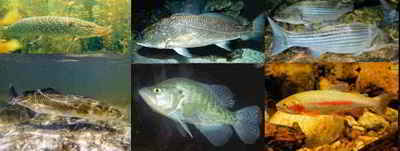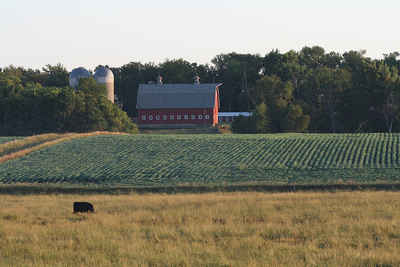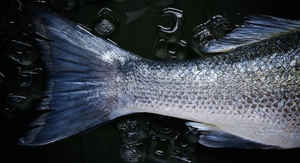South Dakota State Fish
Walleye

(Stizostedion vitreum)
Adopted in February 1982.
The walleye, (Stizostedion vitreum,) was adopted as the state fish of South Dakota in February of 1982, as well as the most sought-after game fish in South Dakota. National sportswriters who have fished the Missouri River reservoirs and the Glacial Lakes now proclaim South Dakota the "Walleye Capital" of America.
South Dakota State Fish: Walleye

The walleye is deemed prized table food and on the Missouri River reservoirs alone, anglers spend over 1.3 million hours each year fishing for walleye. Walleye fishing is a major recreational pastime for many South Dakotans and generates significant economic activity in the state. Based on limited archeological investigations it appears that walleye was not an important dietary component for American Indians inhabiting the South Dakota area.
Characteristics of the Walleye
In South Dakota, walleye can grow to exceed 30 inches (76.2 cm) and 12 pounds (5.45 kg). The average length is 14 inches (35.6 cm) and the state record is 15 pounds 3 ounces (6.9 kg), caught April 7, 1979 in Lake Sharpe. Walleyes can live longer than 10 years, although most walleyes average about 3 years in age.
Walleye have a milky cast to their eyes. They have a long, round, olive body that has gold flecks on the sides with a white tip to the lower fork of the tail. There is a distinct black blotch on the rear end of the first dorsal fin. The walleye is the largest member of the perch family, and has the characteristic spiny dorsal fin as well as the soft dorsal fin. It can grow to lengths of over 2 feet. The walleye's body shape is elongate, streamlined, and slightly compressed. The color of this fish is variable. It is generally brownish yellow to grayish yellow on the back and sides, shading to white on the belly. The dorsal fin is generally dusty or clear with the last few membranes being black. The bottom lobe of the tail fin has a characteristic white tip. Young walleyes show vague saddle-shaped bands on the body. Walleyes differ from yellow perch in that they possess large canine-like jaw teeth. In many lakes, walleye are the predominate predator species.
Common Names

Walleyed Pike, pickerel, walleyed pike, marble-eye and walleyed pike perch. The names stem largely from the walleye's glassy, silvery eyes.
Walleye: given because of the smoky, silvery eye, which is said to be similar to that of blinded or "walleyed" domestic animals
Stizostedion (steezo-stead-eeon) means "pungent throat", according to the namer
vitreum (vit-tree-um) means "glassy", alluding to the nature of the large, silvery eyes
Habitat:
Walleye are most numerous in large, cool, windswept lakes with low to moderate clarity. They also live in large rivers. The preferred water temperature is 65-75 degrees F.
Feeding Behavior:
Walleye most prefer other fish, but also eat aquatic insects, leeches, crayfish, snails, and larval salamanders. They normally feed in dim light.
Reproductive Behavior (Spawning):
Walleye spawn in April and early-May when water temperatures in the shallows reach 4-7 degrees C (40-45 degrees F). In South Dakota this is usually late April. Spawning occurs over gravel beaches or shoals in lakes. Walleyes will sometimes make spawning migrations up rivers. In South Dakota, walleyes in Lake Oahe congregate in the western tributaries for spawning . Spawning takes place at night. Walleye normally spawn during the night hours in about 0.3-1.5 m (1-5 ft) of water. Walleyes are not territorial, and no nest is built. Walleye are broadcast spawners, which means they swim above the spawning substrate (bottom material) and release their eggs and sperm into the water. Females release 200-300 eggs at a time, while one or more males fertilize them. This spawning act is repeated at roughly 5-minute intervals. A female may release all her eggs in a single night or may spawn over a period of several nights. Most males spawn for several nights. The fertilized eggs fall to the bottom, where they stick to the gravel or other bottom material. The parents give no care to the developing eggs (embryos actually) or the larvae that hatch from them. The embryos hatch in about 1-3 weeks, depending on the water temperature. In lakes, the larval walleye soon move into the deep, open water, where they develop into juveniles at about 25-30 mm. At this size they often return to the near shore areas of the lake, a movement pattern similar to the yellow perch.
Distribution:
Walleyes are found throughout South Dakota. However, because walleye require a "cool-water" habitat, they occur primarily in the eastern glacial lakes and in the Missouri River reservoirs. In Western South Dakota, walleye are found in large irrigation reservoirs like Shadehill, Angostura, and Orman. Eastern lakes with notable walleye fisheries include Kampeska, Poinsett, Enemy Swim, and Thompson. All the Missouri River reservoirs are well known for their walleye fisheries. There are many other lakes throughout South Dakota that have walleye fisheries, some of which vary from year to year.
South Dakota Law
The law designating the rwalleye as the official South Dakota state fish is Section 1-6-15 (Statefish) of the South Dakota Statutes, Title 1 (STATE AFFAIRS AND GOVERNMENT) Chapter 6 (STATE EMBLEMS) Section 1-6-15.
TITLE 1 - STATE AFFAIRS AND GOVERNMENT.
CHAPTER 6. STATE EMBLEMS.
SECTION 1-6-15.
1-6-15. State fish. The walleye, Stizostedion vitreum, is the official fish of the State of South Dakota.
Source: SL 1982, ch 5.
Taxonomic Hierarchy: Walleye
Kingdom: Animalia-- animals
Phylum: Chordata - chordates
Subphylum: Vertebrata - vertebrates
Superclass: Osteichthyes
Class: Perciformes
Order: Percidae
Family: Stizostedion
Genus: Stizostedion vitreum








